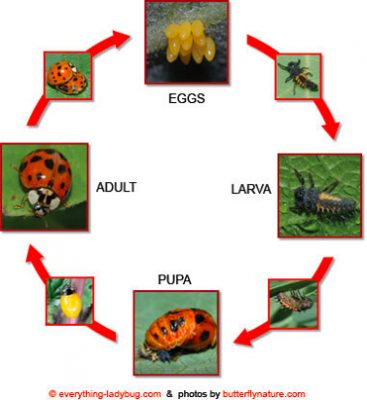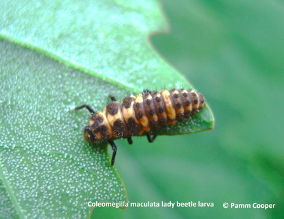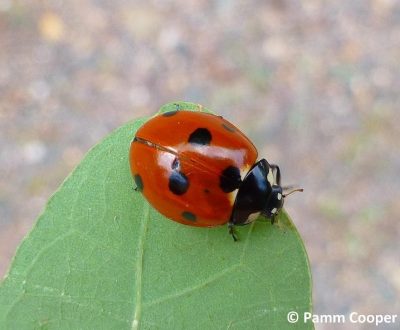“Lady bug, Lady bug, fly away home.” The children’s nursery rhyme reminds us that this little spotted red bug that is found in many planted areas can come and go as it wishes, just by taking to the air. This cute insect is a member of the beetle family and comes in many different patterns and colors. They are also called ladybirds or ladybird beetles.

An old European legend says that the name “ladybug” started when farmers prayed to the Virgin Mary for help when masses of aphids were destroying their crops. Large numbers of red, spotted beetles appeared and devoured the aphids. Grateful for their assistance, the farmers called the insects “Our Lady’s beetles” so the name has remained. There are over 500 types of ladybugs identified in the US and more than 4000 worldwide.
As members of the beetle family (Cleoptera), and not the “true” bug family (Hemiptera), they undergo a complete life cycle in their development.

Eggs are tiny, oval, and arranged in clusters.
Larvae look a bit like alligators, with a body covered in tiny bristles. Pupae are roundish, can be dark colored, and may have spots.
Adults are sphere-shaped, smooth, and show a variety of colors and markings. Adults can live up to a year.



(notice the spot pattern on this type)
Lady beetles can be both predator and prey. Aphids are a favorite food but they also eat soft-bodied insects, such as scale insects, spider mites and mealybugs. They will also eat other insects’ eggs. Some varieties will eat plant pollen and mildew that develops on plant leaves.
Lady beetles aren’t often eaten by birds due to a fluid they produce that makes them taste bad. But other insects such as assassin bugs, stink bugs, spiders and toads may devour them. However, their bright color and spotted patterns serve as a warning to predators to avoid them due to their bad taste.
Ladybugs are not native to the United States. They likely arrived when they were imported to help control aphids that were damaging crops, or they may have been on plants that arrived in the US from Europe, Africa or Asia.
During cold weather months lady bugs may seek shelter inside buildings that they enter through small cracks or crevices. They will gather in masses to stay warm but they don’t cause damage and will fly away when warm weather returns.

Welcome these colorful and important members of the insect world when they appear in your yard.